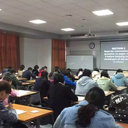Monoterpenoid indole alkaloids from Gardneria multiflora.
Keywords
Abstract
Six new monoterpenoid indole alkaloids, 19(E)-9-demethoxy-16-dehydroxylchitosenine-17-O- β-d-glucopyranoside (1), 19(E)-9,10-didemethoxy-16-dehydroxylchitosenine-17-O-β-d-gluco-pyranoside (2), 19(E)-9,10-didemethoxy-16-dehydroxyl-11-methoxychitosenine (3), 19(E)-9,10-didemethoxy-16-dehydroxyl-11-methoxychitosenine-17-O-β-d-glucopyranoside (4), 19(Z)-18-carboxylgardneramine (5), and 19(E)-18-demethoxygardneramine-N (4)-oxide (6), along with four known alkaloids, were isolated from Gardneria multiflora, and their structures were elucidated by spectroscopic analysis. Compounds 1, 2 and 4 are the first example of Gardneria alkaloids whose glucose units were attached to C-17. None of the compounds were cytotoxic to any of five human cancer cell lines.



